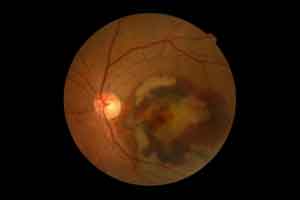- Home
- Editorial
- News
- Practice Guidelines
- Anesthesiology Guidelines
- Cancer Guidelines
- Cardiac Sciences Guidelines
- Critical Care Guidelines
- Dentistry Guidelines
- Dermatology Guidelines
- Diabetes and Endo Guidelines
- Diagnostics Guidelines
- ENT Guidelines
- Featured Practice Guidelines
- Gastroenterology Guidelines
- Geriatrics Guidelines
- Medicine Guidelines
- Nephrology Guidelines
- Neurosciences Guidelines
- Obs and Gynae Guidelines
- Ophthalmology Guidelines
- Orthopaedics Guidelines
- Paediatrics Guidelines
- Psychiatry Guidelines
- Pulmonology Guidelines
- Radiology Guidelines
- Surgery Guidelines
- Urology Guidelines
New Retina scanner detects diseases before vision loss occurs

SFU engineering science professor Marinko Sarunic has developed a high-resolution retinal imaging scanner that will one day revolutionize eye care, helping ophthalmologists diagnose eye diseases before vision loss occurs.
The retina is the light-sensitive tissue at the back of the eye. Its 100 million photoreceptors convert light into the images that our brain ‘sees.’
Today, there are approximately one million Canadians with vision loss caused by major eye diseases such as wet age-related macular degeneration (Wet AMD), diabetic retinopathy, glaucoma and others. The prevalence of vision loss in Canada is expected to double in the next 25 years. An estimated 75 percent of vision loss can be treated or prevented through early detection.
Sarunic’s high-resolution scanner is on the cutting edge of vision science because it can produce high-resolution, 3-D cross-sectional images of the retina—including individual photoreceptors, and fine capillaries, or blood vessels. And unlike other high-resolution retinal scanners, which are the size of a billiard table, Sarunic’s is the size of a shoebox. It’s perfect for everyday use in medical clinics and hospitals.
“It’s a breakthrough in clinical diagnostics,” says Sarunic. “With the high-resolution scanner, ophthalmologists and optometrists can detect damage and changes to small numbers of individual photoreceptors, giving them a diagnosis before the patient loses vision, and the potential to take preventative measures.”
Currently, physicians use low-resolution scanners that can only assess and diagnose the cause of dead retina cells after a patient’s vision is impacted. Last year, ophthalmologists at Vancouver General Hospital’s (VGH) Eye Care Centre spent eight months testing Sarunic’s high-resolution scanner.
Dr. Eduardo Navajas, a vitreoretinal specialist, says the scanner eliminates the need for, and the complications related to, dye injections that are currently used to diagnose and monitor eye diseases like diabetic retinopathy and Wet AMD.
“Early detection of abnormal blood vessels caused by Wet AMD and diabetes is essential to saving a patient’s vision,” says Navajas. “Dr. Sarunic’s new imaging technology is benefiting patients, allowing us to diagnose and treat Wet AMD and diabetic eye disease before patients develop bleeding and permanent damage to their retina.”
FAST FACTS:
- Today, there are approximately one million Canadians with vision loss caused by major eye diseases such as wet age-related macular degeneration (Wet AMD), diabetic retinopathy, glaucoma and others.
- The prevalence of vision loss in Canada is expected to double in the next 25 years
- The scanner eliminates the need for, and the complications related to, dye injections that are currently used to diagnose and monitor eye diseases like diabetic retinopathy and Wet AMD
- 75 per cent of vision loss can be treated or prevented through early detection.
- Wet AMD accounts for 90 per cent of the severe vision loss caused by macular degeneration
- Diabetic retinopathy occurs in people who have diabetes. It causes progressive damage to the retina. Diabetic retinopathy is a serious, sight-threatening complication of diabetes.
- Glaucoma is a complicated disease in which damage to the optic nerve leads to progressive, irreversible vision loss. Glaucoma is the second leading cause of blindness.

Disclaimer: This site is primarily intended for healthcare professionals. Any content/information on this website does not replace the advice of medical and/or health professionals and should not be construed as medical/diagnostic advice/endorsement or prescription. Use of this site is subject to our terms of use, privacy policy, advertisement policy. © 2020 Minerva Medical Treatment Pvt Ltd